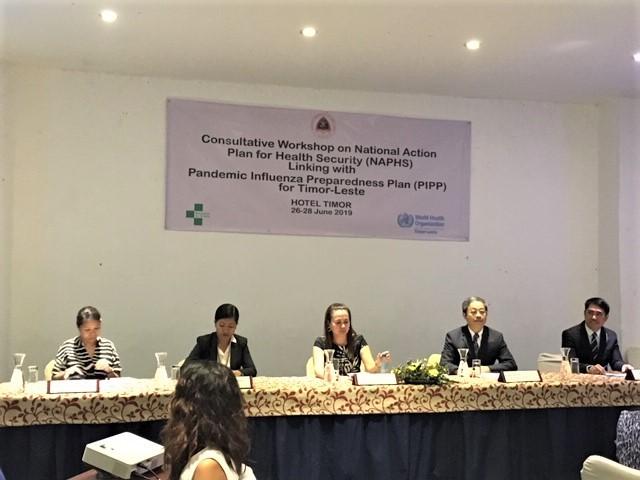
Timor-Leste Boosts Health Security by Aligning NAPHS With Pandemic Influenza Preparedness
August 12, 2019
South-East Asia Region
Timor-Leste
[[{"fid":"3553","view_mode":"default","fields":{"format":"default","alignment":"center","field_file_image_alt_text[und][0][value]":false,"field_file_image_title_text[und][0][value]":false,"external_url":""},"type":"media","field_deltas":{"2":{"format":"default","alignment":"center","field_file_image_alt_text[und][0][value]":false,"field_file_image_title_text[und][0][value]":false,"external_url":""}},"link_text":null,"attributes":{"class":"media-element file-default media-wysiwyg-align-center","data-delta":"2"}}]]
Timor-Leste is making major strides in improving health emergency preparedness, developing a National Action Plan for Health Security (NAPHS) while at the same time linking NAPHS with the country’s Pandemic Influenza Preparedness Plan and National Deployment and Vaccination Plan for greater alignment and efficiency.
Timor-Leste is just the second country in the world, after Ethiopia, to link its NAPHS with disease-specific planning using the resource mapping tool developed by the WHO Strategic Partnership for IHR and Health Security (SPH).
The link between these plans facilitates the effective mobilization of resources, allowing disease-specific funding to be leveraged for the implementation of the country’s NAPHS and the building of long-term and sustainable capacities. One-time rapid response team funding in the Pandemic Influenza Preparedness Plan (PIPP), for example, could be leveraged through the five-year NAPHS for the establishment of a rapid response team that has continuing capabilities to respond to pandemic influenza as well as other health emergencies.
Linking the actions and activities of these plans also avoids duplication of activities, creates synergies and aligns priorities. The work done in Timor-Leste could provide a showcase for the South-East Asia Region and beyond.
The 26-28 June Consultative Workshop on National Action Plan for Health Security (NAPHS) Linking with the Pandemic Influenza Preparedness Plan (PIPP) in Timor-Leste was organized by the Timor-Leste Ministry of Health with support of WHO. The Honorable Vice-Minister of Health of Timor-Leste, Dr Elia A. A. dos reis Amaral, highlighted the health security challenges faced by Timor-Leste in a disaster-prone region impacted by climate change and rapid, unplanned urbanization. The Vice-Minister underscored the country’s commitment to strengthening emergency preparedness and response capacities under the International Health Regulations (IHR, 2005).
[[{"fid":"3552","view_mode":"default","fields":{"format":"default","alignment":"center","field_file_image_alt_text[und][0][value]":false,"field_file_image_title_text[und][0][value]":false,"external_url":""},"type":"media","field_deltas":{"1":{"format":"default","alignment":"center","field_file_image_alt_text[und][0][value]":false,"field_file_image_title_text[und][0][value]":false,"external_url":""}},"link_text":null,"attributes":{"class":"media-element file-default media-wysiwyg-align-center","data-delta":"1"}}]]
More than 86 participants attended the workshop including representatives of government agencies, the National Health Laboratory, national health organizations, UN agencies and other development partners. Domestic and external stakeholders expressed commitment to support the implementation of the NAPHS and PIPP.
The workshop involved review, validation and consensus on strategic priority actions, resulting in a draft NAPHS for Timor-Leste, as well as a draft PIPP and linkages between the NAPHS, PIPP and National Deployment and Vaccination Plan (NDVP).
The impact of the linkages goes beyond pandemic influenza to also include broader preparedness for other Severe Acute Respiratory Infections (SARI). Preparedness for pandemic influenza requires capacities with broad applicability, such as having in place vaccine development plans, procedures and policies.